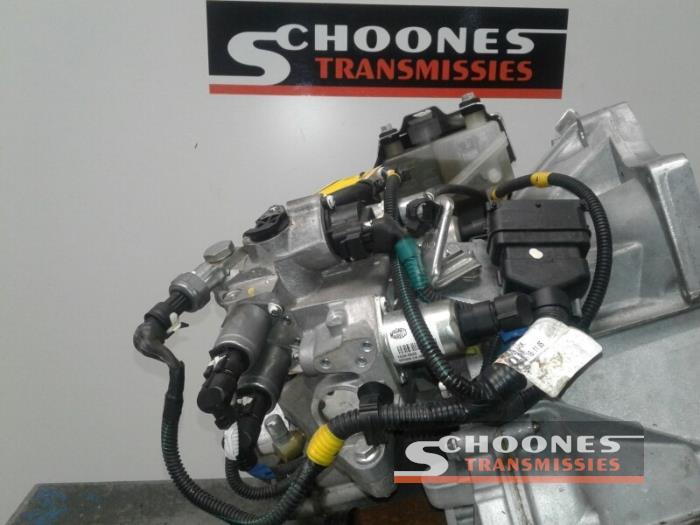You are using an out of date browser. It may not display this or other websites correctly.
You should upgrade or use an alternative browser.
You should upgrade or use an alternative browser.
Alternative Transaxle with existing SOHC Engine
- Thread starter kmead
- Start date
kmead
Old enough to know better
In looking at Ebay and Mopar’s websites the cost of a modern C514, C510 and C635 range from pretty reasonable for a new one, used ones for pretty darn cheap in the US, to dirt cheap in Canada for used.
The issues are that one would need to make an adapter which could be done with CAD (cardboard aided design) to then transfer it to CAD (computer aided design), this is basically a 2D activity so flat DXF file is all that is needed. This part isn’t that difficult but would require having the different transmissions in hand. Yes a scanning system would be desirable but I don’t believe it is absolutely necessary. However this could be farmed out to a service for a price... Cardboard is cheap.
The complexity comes in around how to deal with the starter which due to the engines they were fitted to being turbos, puts the starter on the back to avoid the hot turbo and the SOHC thermostat housing with the cross tube running across the back of the engine roughly where the starter would need to be added. (this is a 635 with the hydro throw out bearing):


In looking at the transmission housings for all three variations of these transmissions (the C635 is a very different transmission used on the 500L, 500X and several Jeeps), there is plenty of material to mill off a thickness of aluminum to make room for an adapter plate and fasteners.
This is the 510, the 514 is similar




The issues are that one would need to make an adapter which could be done with CAD (cardboard aided design) to then transfer it to CAD (computer aided design), this is basically a 2D activity so flat DXF file is all that is needed. This part isn’t that difficult but would require having the different transmissions in hand. Yes a scanning system would be desirable but I don’t believe it is absolutely necessary. However this could be farmed out to a service for a price... Cardboard is cheap.
The complexity comes in around how to deal with the starter which due to the engines they were fitted to being turbos, puts the starter on the back to avoid the hot turbo and the SOHC thermostat housing with the cross tube running across the back of the engine roughly where the starter would need to be added. (this is a 635 with the hydro throw out bearing):
In looking at the transmission housings for all three variations of these transmissions (the C635 is a very different transmission used on the 500L, 500X and several Jeeps), there is plenty of material to mill off a thickness of aluminum to make room for an adapter plate and fasteners.
This is the 510, the 514 is similar
Attachments
Dr.Jeff
True Classic
Karl, thanks for moving this to a new thread. I knew it did not belong with the initial location, it just followed the typical drift. 
I might have missed it, but did you mention the typical prices for used units?
OK, so at the risk of already going off topic (but not really)....
Rather than making an adaptor plate to mount the X's engine onto the newer gearbox, is there any possibility of using the new 500 engine but converting it to non-MultiAir? I'm thinking in terms of simplicity, avoiding all of the hassles of making the MultiAir work in a X (as Tony found). Perhaps even MegaSquirt ECU? Would the more modern design of the 500 engine (less MultiAir) be a better platform to build a performance engine from than the old X SOHC?
I might have missed it, but did you mention the typical prices for used units?
OK, so at the risk of already going off topic (but not really)....
Rather than making an adaptor plate to mount the X's engine onto the newer gearbox, is there any possibility of using the new 500 engine but converting it to non-MultiAir? I'm thinking in terms of simplicity, avoiding all of the hassles of making the MultiAir work in a X (as Tony found). Perhaps even MegaSquirt ECU? Would the more modern design of the 500 engine (less MultiAir) be a better platform to build a performance engine from than the old X SOHC?
kmead
Old enough to know better
The answer at this time for changing a Multiair to a standalone cpu is likely a resounding no.
If Fiat would make a racing standalone ecu we would be in business, I am not aware of one.
The valve system is directly manipulated by the ECU and so far as I am aware it isn’t possible to reverse engineer it. It isn’t done simply like VTEC etc.
The pre Multiair engine likely could be but we never got them.
If Fiat would make a racing standalone ecu we would be in business, I am not aware of one.
The valve system is directly manipulated by the ECU and so far as I am aware it isn’t possible to reverse engineer it. It isn’t done simply like VTEC etc.
The pre Multiair engine likely could be but we never got them.
dcioccarelli
Dominic Cioccarelli
In looking at Ebay and Mopar’s websites the cost of a modern C514, C510 and C635 range from pretty reasonable for a new one, used ones for pretty darn cheap in the US, to dirt cheap in Canada for used.
The issues are that one would need to make an adapter which could be done with CAD (cardboard aided design) to then transfer it to CAD (computer aided design), this is basically a 2D activity so flat DXF file is all that is needed. This part isn’t that difficult but would require having the different transmissions in hand. Yes a scanning system would be desirable but I don’t believe it is absolutely necessary. However this could be farmed out to a service for a price... Cardboard is cheap.
The complexity comes in around how to deal with the starter which due to the engines they were fitted to being turbos, puts the starter on the back to avoid the hot turbo and the SOHC thermostat housing with the cross tube running across the back of the engine roughly where the starter would need to be added. (this is a 635 with the hydro throw out bearing):
View attachment 46015
View attachment 46016
In looking at the transmission housings for all three variations of these transmissions (the C635 is a very different transmission used on the 500L, 500X and several Jeeps), there is plenty of material to mill off a thickness of aluminum to make room for an adapter plate and fasteners.
This is the 510, the 514 is similar
View attachment 46018
View attachment 46018
View attachment 46019
View attachment 46020
Hi Karl,
yes, thanks for the thread. Good idea.
This wouldn't help with the starter motor issue, but would negate any issues relating to shifters or leaking clutch master cylinders: to use one of the robotised manual C510s like this:

Robotised gearbox Fiat 500 Abarth - 55232657 C510
Used Robotised gearbox with part number 55232657 Gearbox code C510 with part number 55232657 Year of construction 2019, Classification code A1, Type of engine Petrol Injection (Turbo) Petrol Injection, Engine capacity 1,400 cc, Gearbox Semi-Auto., Drive Front wheel, Odometer reading 4,212 km...

That said, making room for all the extra components might be quite difficult.
Janis
True Classic
If adapter plate is made, then it can have a place for X starter motor, no?
At my understanding most important things are:
•distance between diff axis and input shaft for clutch to be as close as possible as on X gearbox.
•angle between these two axes to the horizon in donor as close as possible to X angle to keep oil level in the correct level.
•outer distance between diff shafts
If we know X dimensions then can check with these dimensions some cheap/good alternatives.
I was going to take a look at VW golf 3 gearbox this weekend, because it is worth nearly nothing.

*if this gearbox is fitted then maybe after that it is easier to do Audi/VW 4 cyl turbo swap
At my understanding most important things are:
•distance between diff axis and input shaft for clutch to be as close as possible as on X gearbox.
•angle between these two axes to the horizon in donor as close as possible to X angle to keep oil level in the correct level.
•outer distance between diff shafts
If we know X dimensions then can check with these dimensions some cheap/good alternatives.
I was going to take a look at VW golf 3 gearbox this weekend, because it is worth nearly nothing.
*if this gearbox is fitted then maybe after that it is easier to do Audi/VW 4 cyl turbo swap
dcioccarelli
Dominic Cioccarelli
Have a look from 7:26. Searching eBay for 3D scanners now...
MikeHynes
True Classic
That's an eye opener for me. Very topical to this discussion.
I wonder what it would cost for such a scanner, and the software needed to turn the output into something a CNC machine could use to whittle out a part?
Can you imagine having access to a library of transmission scans? Especially if you could search on important attributes? Combine that with a library of the south end of engines and... It's like SCIENCE!
I wonder what it would cost for such a scanner, and the software needed to turn the output into something a CNC machine could use to whittle out a part?
Can you imagine having access to a library of transmission scans? Especially if you could search on important attributes? Combine that with a library of the south end of engines and... It's like SCIENCE!
Pete Whitstone
True Classic
I wonder what it would cost for such a scanner, and the software needed to turn the output into something a CNC machine could use to whittle out a part?
My dentist has such a machine. Granted it is for much smaller scanning jobs (teeth) but he paid $30k for his. I tend to think the one Edd is using is in the "north of $10k" territory, but I don't know.
Bjorn Nilson
True Classic
Are you planning to CNC machine it? If not, making an adaptor from a template from the existing box is not very complicated but would require machines and knowledge.Maybe someone has a precise drawing of gearbox or engine to make an adapter plate?
Maybe you can buy a prefabricated piece (CNC) that fits the engine from Beckert Technology. I think they make an adapter for fitting their own gearboxes to our SOHC so maybe you can buy it "half ready"?
Are you going to swap flywheel and starter as well?
Janis
True Classic
am planning to pick up 02J box tomorrow.
I Imagined that would
1. laser cut small circles with burned point in the middle
2. then put this circles into mounting points of the gearbox
3.put gearbox inside the laser bed with mounting surface facing upwards
4. then pinpoint all dots by mowing laser head while it is pointing exactly into dots, input shaft and stub axle
5. save coordinates of these dots from both vw and X19 box
6. rotate group of dots to each other while center of stub axles maches
7. make a 3D model and give it most likely to someone to cut it on CNC
8. mill off necessary thicness of vw bellhouse
9. attach adapter to vw bellhouse
*adapter will have points to use x19 starter motor
VW box
adapter plate
X19 starter motor
VW clutch disc
X19 pressure plate (bacause I have it new)
X19 flywheel (because I have it lightened already)
and then do the cable mechanism
I’ll try to do this at the level that maybe after my experience it will be much easier for someone else to do the same thing.
If this will work out good then will do a writeup with what is done and which gearboxes fit and what ratios they have.
The one I’ll pick up is with code EBJ 3.389 crown to pinion, total ratio in 5th 2.56. with 15” 195/50 at 100km/h calculated RPMs would be 2360
I Imagined that would
1. laser cut small circles with burned point in the middle
2. then put this circles into mounting points of the gearbox
3.put gearbox inside the laser bed with mounting surface facing upwards
4. then pinpoint all dots by mowing laser head while it is pointing exactly into dots, input shaft and stub axle
5. save coordinates of these dots from both vw and X19 box
6. rotate group of dots to each other while center of stub axles maches
7. make a 3D model and give it most likely to someone to cut it on CNC
8. mill off necessary thicness of vw bellhouse
9. attach adapter to vw bellhouse
*adapter will have points to use x19 starter motor
VW box
adapter plate
X19 starter motor
VW clutch disc
X19 pressure plate (bacause I have it new)
X19 flywheel (because I have it lightened already)
and then do the cable mechanism
I’ll try to do this at the level that maybe after my experience it will be much easier for someone else to do the same thing.
If this will work out good then will do a writeup with what is done and which gearboxes fit and what ratios they have.
The one I’ll pick up is with code EBJ 3.389 crown to pinion, total ratio in 5th 2.56. with 15” 195/50 at 100km/h calculated RPMs would be 2360
Last edited:
Dr.Jeff
True Classic
Janis has access to some rather nice equipment and can do amazing things with it. 
I know there are some companies that make adaptors to fit the VW 8-valve engines to various other gearboxes (i.e. the opposite of what you will do), and some that make adapters to fit all sorts of other engines to the old air-cooled VW transaxle (from rear engine VWs). Take a look at their sites to see if they offer any info you can use. Below is a master list of engine adapter companies in general. Scroll through all of it to see who might have something (the list isn't necessarily organized in any particular order regarding applications):

 engineswapdepot.com
engineswapdepot.com
I know there are some companies that make adaptors to fit the VW 8-valve engines to various other gearboxes (i.e. the opposite of what you will do), and some that make adapters to fit all sorts of other engines to the old air-cooled VW transaxle (from rear engine VWs). Take a look at their sites to see if they offer any info you can use. Below is a master list of engine adapter companies in general. Scroll through all of it to see who might have something (the list isn't necessarily organized in any particular order regarding applications):
Bellhousing and Transmission Adapters
These companies offer adapters to help with installing a transmission to a specific engine. Please contact us to submit a product or kit. Use at your own risk. These are adapters we have come across while researching for articles. We have not been paid to post or make any claims to their...
Dr.Jeff
True Classic
Paint it all black then add some undercoating and dirt on top of that. They'll never see what is actually in there. Plus I doubt they know what it should look like anyway.and one more thing that I would have to do
make it look like stock, otherwise dont think it could be street legal with milled bellhouse, not sure about adapter plate
Last edited:
AKimball92
True Classic
I was discussing this with an engineering neighbor this week. I did not think about milling the bellhousing to compensate for the adaptor plate. The plates seem to be 1/2" aluminum or thicker. Is there enough meat on most bell housings to mill off that much and still have adequate thread engagement to clamp together? If that were the case there is way too much material and bolt length in the OEM design. Knowing how much OEMS are squeezing every penny out of the vehicles, this would be concerning.
Rupunzell
Bernice Loui
Cut the original bell housing mounting off, make the adapter plate, weld on the adapter plate.I was discussing this with an engineering neighbor this week. I did not think about milling the bellhousing to compensate for the adaptor plate. The plates seem to be 1/2" aluminum or thicker. Is there enough meat on most bell housings to mill off that much and still have adequate thread engagement to clamp together? If that were the case there is way too much material and bolt length in the OEM design. Knowing how much OEMS are squeezing every penny out of the vehicles, this would be concerning.
Sounds real simple, to actually do this is extremely involved and not easy or simple.
Factors to consider are gear box input shaft to clutch disc, clutch release bearing, proper alignment of the input shaft to flywheel and all that.
Ya gotta really wanna do this. IMO, not worth while for production gear boxes due to availability of gear ratios to meet specific goals.
Bernice

